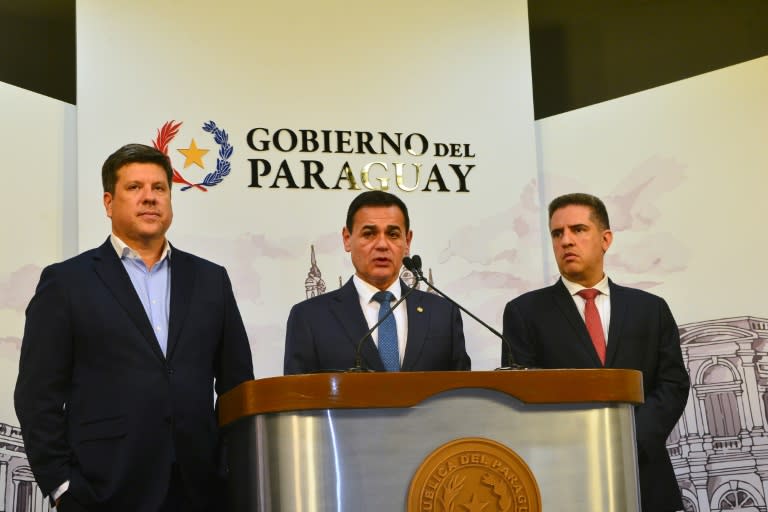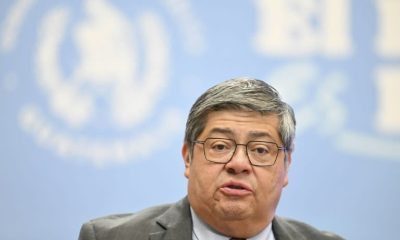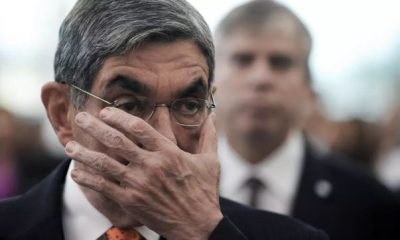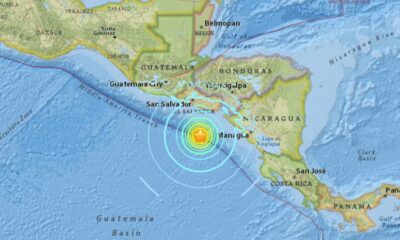International
Two dead, more than 3,000 buildings damaged in Mexico earthquake

AFP
Two people were killed and more than 3,000 buildings were damaged by a powerful 7.7 magnitude earthquake that struck Mexico on the anniversary of two devastating tremors, authorities said Tuesday.
A woman died of injuries caused by a falling wall in Manzanillo in the western state of Colima, civil defense national coordinator Laura Velazquez told reporters.
A man was killed by falling debris in a shopping center in the same city during Monday’s earthquake, which caused buildings to shake and sway in Mexico City.
President Andres Manuel Lopez Obrador said it was lucky that the death toll was not higher.
“It was a tremor of considerable intensity,” he said.
The epicenter was located near the Pacific coast, around 400 kilometers (250 miles) west of the capital and 59 kilometers south of Coalcoman in the state of Michoacan, according to seismologists.
The depth was estimated at 15 kilometers.
At least 26 people received hospital treatment in Michoacan, where authorities reported damage to 3,161 houses as well as several dozen education and health centers.
Nine people were injured in Colima, where more than 150 houses and other buildings were damaged, officials said.
There were hundreds of aftershocks, the most powerful of which was magnitude 5.8, according to the national seismological agency.
The earthquake struck less than an hour after millions of people in Mexico City participated in emergency drills on the anniversary of two previous disasters.
“It was very scary. I thought, on the 19th again, it can’t be,” said Laura Plaza, a retired teacher.
On September 19, 1985, an 8.1 magnitude quake killed more than 10,000 people and destroyed hundreds of buildings.
On the anniversary of that earthquake in 2017, a 7.1 quake left around 370 people dead, mainly in the capital.
The timing of Monday’s tremor was no more than a coincidence, the national seismological agency said.
“There is no scientific reason to explain it,” it added.
Mexico sits in the world’s most seismically and volcanically active zone, known as the Ring of Fire, where the Pacific plate meets surrounding tectonic plates.
Mexico City, which together with surrounding urban areas is home to more than 20 million people, is built in a natural basin filled with the sediment of a former lake, making it particularly vulnerable to earthquakes.
The capital has an early warning alarm system using seismic monitors that aims to give residents enough time to evacuate buildings when earthquakes hit seismic zones near the Pacific Coast.
International
Javier Milei vows to work ‘side by side’ with the U.S. on trade rules

Determined to work “side by side” with the United States, Argentine President Javier Milei announced in Mar-a-Lagothat his government will modify trade regulations to meet the requirements of Donald Trump’s newly imposed tariffs.
Milei arrived in Florida amid the trade war triggered by the latest round of tariff hikes announced by the Republican leader. While many countries are considering retaliation, Milei’s ultraliberal Argentina has opted to adapt instead.
“Argentina will move forward in adjusting its regulations to comply with the reciprocal tariff proposal drafted by President Trump,” Milei stated at the Gala of American Patriots, organized by the Make America Clean Again (MACA) Foundation and the We Fund the Blue NGO, according to his office.
He further explained that Argentina has already met nine out of the 16 necessary requirements and has instructed his administration to comply with the remaining ones in order to resolve trade asymmetries with the U.S. in a short time frame.
International
Paraguay summons Brazilian ambassador over Itaipú espionage scandal

Paraguay summoned the Brazilian ambassador in Asunción on Tuesday to demand “explanations” and called its own representative in Brasília for consultations following Brazil’s acknowledgment of an espionage operation. The Brazilian government, led by President Luiz Inácio Lula da Silva, attributed the operation to the previous administration.
The surveillance effort aimed to uncover Paraguay’s position in now-suspended negotiations with Brazil regarding the pricing of electricity from the binational Itaipú hydroelectric plant, according to reports in the Brazilian press.
The Brazilian government “categorically denied any involvement in the intelligence operation,” stating in a Foreign Ministry communiqué on Monday that the espionage was carried out under former President Jair Bolsonaro’s administration (2019-2023).
“The operation was authorized by the previous government in June 2022 and was annulled by the interim director of the (state intelligence agency) ABIN on March 27, 2023, as soon as the current administration became aware of it,” Brazil’s government asserted.
Paraguay’s Foreign Minister Rubén Ramírez announced that Brazilian Ambassador José Antonio Marcondes de Carvalho was summoned “to provide detailed explanations” regarding the operation. Additionally, Paraguay recalled its diplomatic representative in Brasília “to report on aspects related to the intelligence activity conducted by Brazil regarding Paraguay’s government affairs.”
International
Elon Musk to step down as government advisor, per Trump insiders

President Donald Trump has informed his inner circle that Elon Musk will be stepping down from his role as a government advisor, according to a report by Politico today.
Citing three individuals close to Trump, Politico states that the president is pleased with Musk’s leadership at the Department of Government Efficiency (DOGE), where he has implemented significant budget cuts. However, both have agreed that it is time for Musk to return to his businesses and support Trump from a different position outside the government.
A senior administration official told Politico that Musk will likely maintain an informal advisory role and continue to be an occasional visitor to the White House. Another source warned that anyone thinking Musk will completely disappear from Trump’s circle is “deluding themselves.”
According to the sources, this transition is expected to coincide with the end of Musk’s tenure as a “special government employee,” a temporary status that exempts him from certain ethics and conflict-of-interest regulations. This 130-day period is set to expire in late May or early June.
-

 International3 days ago
International3 days agoParaguay summons Brazilian ambassador over Itaipú espionage scandal
-

 Sports3 days ago
Sports3 days agoFilipe Luis debuts as coach in Copa Libertadores with Flamengo
-

 Central America3 days ago
Central America3 days agoGuatemalan police officer killed in mob riots over baby kidnapping
-

 International3 days ago
International3 days agoElon Musk to step down as government advisor, per Trump insiders
-

 Sports3 days ago
Sports3 days agoVenezuela investigates 18 baseball players seeking asylum in Spain
-

 International3 days ago
International3 days agoÓscar Arias: Trump’s trade policies are a step backward
-

 Central America1 day ago
Central America1 day agoPanama’s former president Martinelli claims political enemies tried to kill him
-

 International3 days ago
International3 days agoMilei vows to make Argentina so strong that Falkland Islanders “choose” to join
-

 International1 day ago
International1 day agoJavier Milei vows to work ‘side by side’ with the U.S. on trade rules
-

 International3 days ago
International3 days agoICE agent’s arrest of suspect sparks controversy in Boston





























